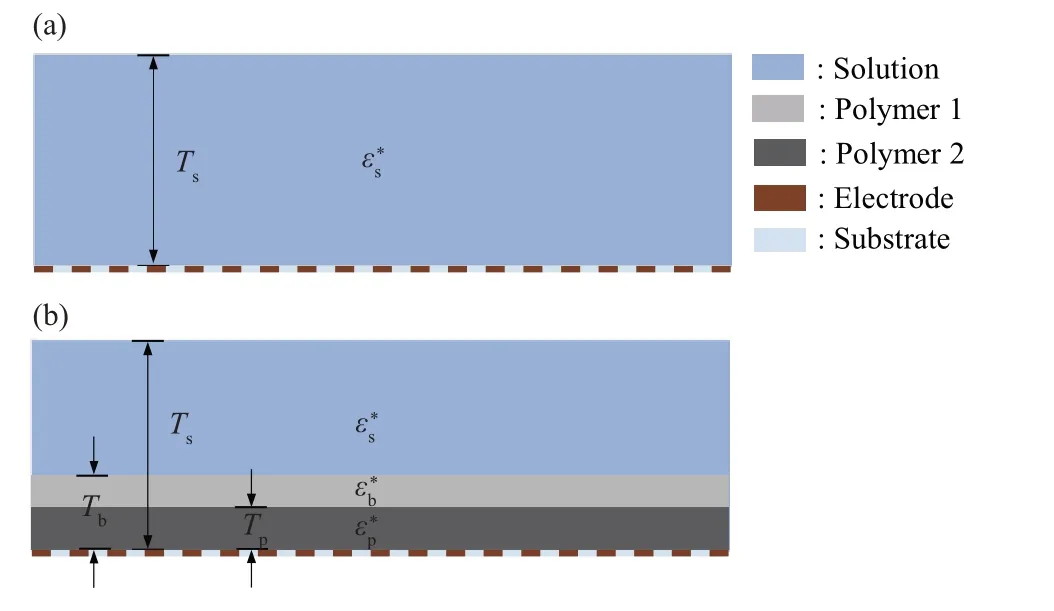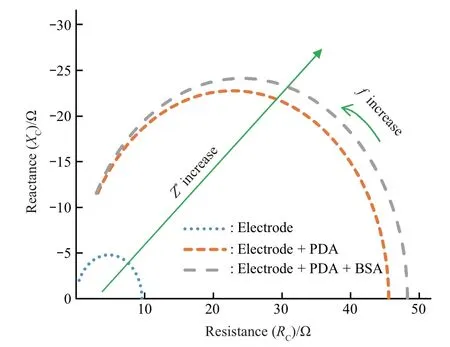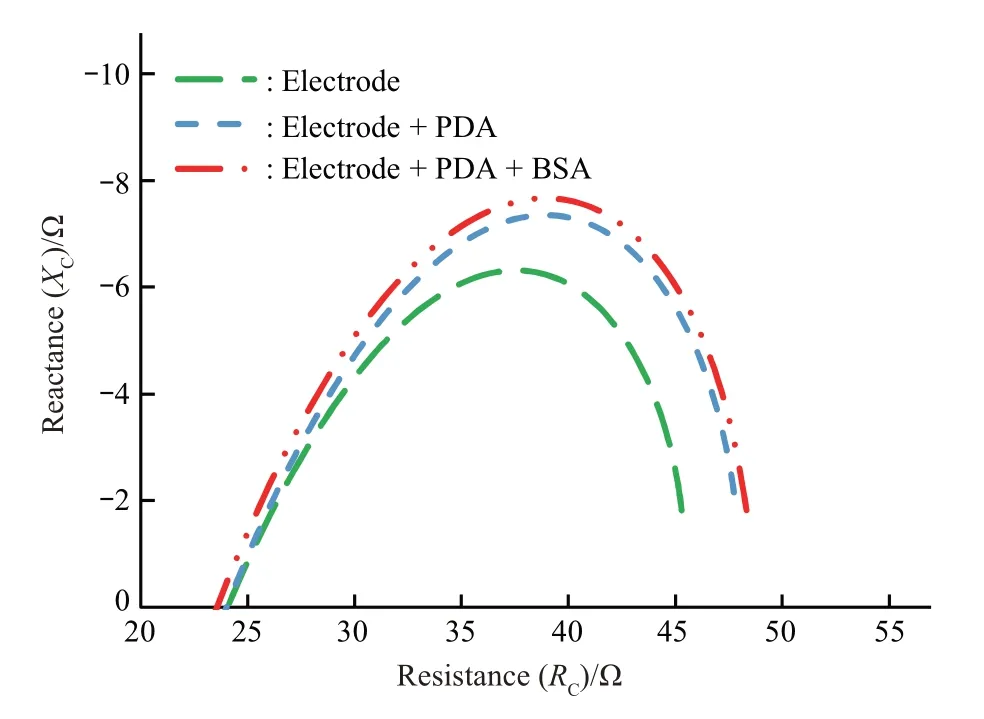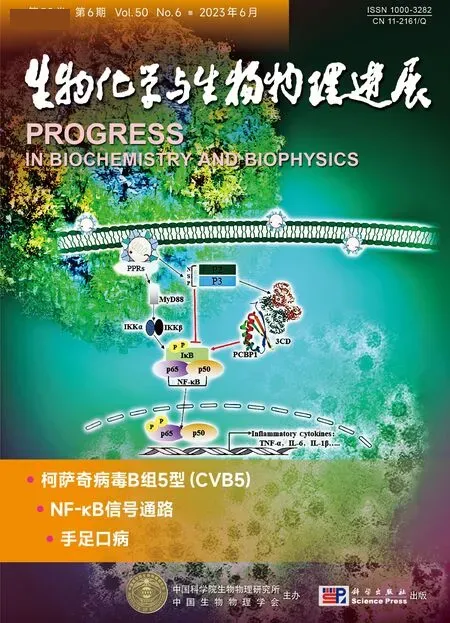Study on Characteristics of Multilayer Biosensor*
HE Li-Dong, LI Jian-Ping, WEI Bi-Qian, WEN Jian-Ming, LIU Hao, MA Ji-Jie,HU Yi-Li, ZHANG Yu, WAN Nen, LI Ning3)
(1)College of Engineering, Zhejiang Normal University, Jinhua321004,China;2)College of Information Science and Engineering, Jiaxing College, Jiaxing314000,China;3)Hangzhou Innovation Institute, Beihang University, Hangzhou310051,China)
Abstract Objective Biosensors with multilayer biomedia are widely applied in various fields, and quantitative characterization of biosensors is still a problem for the development of sensors. This study is to quantitatively characterize the electrical properties of multilayer biomedia. Methods Combined with conformal mapping theory, the quantitative characteristics of biosensors are explored based on electrical impedance spectroscopy for clarifying the law of influence on impedance, and this study provides a basic theory for the characterization of biosensors. The impedance (Z*) of each biomedia layer is extracted, and the simulation and calculation are executed to study the correctness. Results An experimental system has been established, results show that the impedance(Z*) of the detection area continues to rise from the frequency (f) = 0.1 MHz to f=50.0 MHz in the coating process. This trend is explained that the solution in the original detection area is covered by the coating of biological medium with different dielectric properties, resulting in a decrease in the conductivity of the detection area and an increase in the impedance. Theoretical calculation results and simulation results show a great agreement with experimental results. Conclusion This study confirms that the multilayer biosensors are able to be quantitatively characterized based on electrical impedance spectroscopy and conformal mapping,which has certain practical value for the further development of biosensors.
Key words biosensor, multilayer biomedia, electrical impedance spectroscopy, conformal mapping, impedance
Biosensors with high detection sensitivity, low production cost and convenient operation are widely applied in various fields, such as ecological environment monitoring[1-5], food safety detection[6-10],medical disease diagnosis[11-13]and bioengineering[14].With the rapid development of biosensors, the requirements for structure design and performance of biosensors have been increased continuously by research scholars. The selection of electrodes, the modification process and the improvement of materials are the keys to achieve stable signal conversion and transmission. For example, interdigital electrodes are extensively used in biosensors due to its unique comb-like structure, high sensitivity and fast response speed. Functionalized biosensors were used to detect the concentration of acquired immune deficiency syndrome (AIDS-)killing anaphylaxis[15-16],and micro biosensors were used forin situnoninvasive detection of glucose in sweat[17]. There are already numerous researches on biosensors in the past decades all over the world. It is seen that biosensors have important function in the aspect of rapid disease diagnosis, life quality protection and life safety maintenance.
Biosensors are mainly composed of planar electrodes which has been modified one or more layers of polymers on the surface by physical or chemical means. Combined with electrical impedance spectroscopy, the output signals are obtained by sweeping frequency under the electrode polarization band to illustrate the change caused by the adsorption of the medium. Existing researches optimize and theoretically verify the structural parameters of biosensors, which are widely promoted in substance detection. Ruiet al.[18]proposed the analytical expression of the periodic interdigital electrode capacitive sensor, and studied the capacitance characteristics of the multilayer dielectric layer and the interdigital electrode parameters. Wanget al.[19]calculated the planar capacitance characteristics in the multilayer dielectric structure which was simulated and verified, and the capacitance of the interdigital electrodes with different parameters of the dielectric structure was compared. Ibrahimet al.[20]studied the influence of electrode geometric parameters on impedance spectrum to optimize three-dimensional biomedium-loaded sensors. Biosensors with improved performance have played a very important role in various fields. Rajiburet al.[21]designed and developed a taste sensor array based on the interdigital capacitor, which was combined with various tastes by spin-coating lipids. This method has the advantages of real-time monitoring capability and high sensitivity through voltage changes caused by different tastes and lipid binding. Junget al.[22]developed a capacitive biosensor with nano-island structure interdigital electrodes for antigen-antibody interaction. In recent years, the research on the optical/electrical properties of multi-layer coatings has continued to deepen, but the current research mostly stays on the qualitative research of the multi-layer uniform biological medium structure. The research and theoretical exploration of the quantitative characteristics of the multi-layered biological medium need to be further explored.
In this study, characteristics of multilayer biological medium based on the electrical impedance spectroscopy has been explored. Combined with the method of conformal mapping, the plane electrode is converted into a parallel electrode, which expands the original theory. The simulation and calculation of multilayer model are executed. An experimental system has been established and the results show that impedance increases with the modifying process of the medium, and the theoretical calculation results and simulation results show a great agreement with the experimental results. This study presents a method for quantifying the electrical impedance properties of multilayer biomedia based on conformal mapping and electrical impedance spectroscopy.
1 Materials and methods
1.1 System
Figure 1a shows the detection system for multilayer biomedia electrical impedance spectrum characteristic, and it is mainly composed of a detection container, an impedance analyzer, a dedicated impedance fixture device and a PC. The detection container is consisted of periodic interdigitated electrodes which is made of gold by lithography and polymethyl methacrylate (PMMA)cavity, and the detailed dimensions are shown in Figure 1b: the electrode line width (W)=100 μm, the line spacing (D) =100 μm, and the number of electrodes (N)=20. Figure 1c shows the multilayer biomedium structure detected in the experiment. A bottom-up layers are the electrode layer,polydopamine (PDA) layer, bovine serum albumin(BSA) layer and sodium chloride (NaCl) solution layer. The detection container is connected to the data detection terminal of the impedance analyzer (Hyoki,IM7581) through a special impedance fixture device(Hyoki, IM9200). The impedance analyzer applies a current (I)=0.001 A to the detection container and sweeps the frequency (f) fromf=0.1 MHz tof=300.0 MHz which used to measure the electrical impedance spectrum characteristics of multilayer biomedia. The PC is connected to the data transmission port of the impedance analyzer for data processing and storage.
1.2 Theoretical analysis
The equivalent circuit of periodic interdigitated electrodes is shown in Figure 2.According to earlier studies[18,23],CI*presents the half complex capacitance of an inner electrode relative to the ground potential,andCE*presents the complex capacitance of an outer electrode relative to the ground plane beside to it. The total complex capacitance (C*) will be calculated by the method of conformal mapping:
whereε0is the permittivity of air,εmis the permittivity of the medium,σmis the conductivity of the medium,εm
*is the complex permittivity of the medium,Lis the electrode finger length,Nis the number of electrodes,andK(k) is complete elliptic integrals of the first kind,kIandkEare the elliptic modulus of the inner electrode and the outer electrode, respectively,k'Iandk'Eare the complementary modulus of the inner electrode and the outer electrode, respectively.

Fig. 1 Detection device

Fig. 2 Equivalent circuit diagram of periodic interdigital electrode

Fig. 3 Cross section diagram of periodic interdigital electrode detection

Fig. 4 Equivalent diagram of multilayer biological medium

Fig. 5 Theoretical calculation results

Fig. 6 Finite element analysis and results

Fig. 7 Impedance frequency characteristic curve of modified electrode

Fig. 8 Nyquist curve of modified electrode
According to the impedance calculation formula[24-27], it can be obtained:
whereZ*is the impedance,jis the imaginary unit,ωis the angular frequency, andfis the frequency.
The schematic cross-section of the periodic interdigital electrode is shown in Figure 3. Figure 3a shows a schematic cross-sectional view of a singlelayer dielectric.Tsandεsare the thickness and dielectric constant of the solution dielectric layer,respectively. Figure 3b shows a schematic crosssectional view of a multilayer dielectric.Tbandεbare the thickness and dielectric constant of the polymer 1 dielectric layer, respectively;Tpandεpare the thickness and dielectric constant of the polymer 2 dielectric layer, respectively. The electrode width isW=100 μm, the electrode spacing isD=100 μm, the number of electrodes isN=20, and the electrodes are embedded in the substrate so the thickness is negligible.
The impedance of a single-layer medium can be obtained according to equations (1)-(5):
whereεs*is the complex permittivity of the solution,σsis the electrical conductivity of the solution,CIs*,CEs*are the complex capacitances of the internal and external electrodes of the solution,Cs*is the complex capacitance of the solution,Zs*is the impedance of the solution,kIs,kEsare the elliptic moduli of the inner and outer electrodes of the solution, respectively, andkIs'andkEs' are complementary moduli.
As shown in Figure 4, the multilayer biological medium is approximately divided into the sum of multiple single-layer biological mediums supported by recent research. The formula based on equations(1)-(5) for impedance which are described by:
whereεi*andσiare the complex permittivity and conductivity of bovine serum albumin, polydopamine and the solution, respectively;CIi*andCEi*are the complex capacitance of BSA, polydopamine and the inner and outer electrodes of the solution,respectively;Ci*is the complex capacitance of bovine serum albumin (BSA), polydopamine and the solution,Ct*is the total complex capacitance,Zt*is the total impedance,kIiandkEiare the elliptic modulus of bovine serum albumin, polydopamine and the inner and outer electrodes of the solution, respectively;kIi'andkEi' are complementary moduli.
2 Results and discussion
2.1 Theoretical calculation results
The theoretical formula is introduced in MatLab to verify the the feasibility of the experiment.During the process of parameter setting, since the permittivity and conductivity of each biological medium are related to the electrical impedance characteristics, the parameters are estimated and set in the theoretical calculation process (εs>εb>εp,σs>σb>σp).
The numerical results are shown in Figure 5 under the condition that the input frequenc is swept from 0.1 MHz to 300.0 MHz.Figure 5 describes that after the electrode is coated with PDA, its arc is significantly larger than the arc without coating effect,which means the impedance value of the electrode detection area indicates an upward trend;further, after BSA coating, its arc is slightly enlarged compared with that under PDA coating, which also displays that the impedance value of the electrode detection area presents an upward trend.Overall, the theoretical calculation results show an upward trend.
2.2 Simulation results
The feasibility of experiments are verified by theoretical analysis. As shown in Figure 6,the multiphysics finite element analysis, grasping the characteristics, parameters and functions of each module systematically and judging the practicability of the system, is applied to explore the influence of the impedance characteristics.The finite element simulation structure is simplified, three pairs of plane electrodes are arranged, the interval is kept same, and the input current is 10 mA. The sweep frequency range is 0.1 MHz to 800.0 MHz for observing the test trend visually.In the multi-physics finite element analysis process, the multilayer biological structure is drawn according to the theoretical structure which is assigned different permittivity and conductivity (εs>εb>εp,σs>σb>σp).Figure 6a-c are the potential distribution diagrams of single-layer, double-layer,and three-layer simulated electrode modification.Figure 6d reveals a Nyquist plot of the impedance characteristics of a multilayer dielectric obtained from a multiphysics finite element simulation. It will be explained that, when the electrode is modified by multilayer biological medium, the semicircle of the Nyquist plot becomes larger. In general, there is an increasing trend consistent with the theoretical calculation results in Figure 5.
2.3 Experiment results
Figure 7 shows the impedance-frequency characteristic curve of the modified multilayer biological medium. Especially, Figure 7a indicates that, impedance changes from frequency (f)=0.1 MHz to 50.0 MHz under the condition of different medium modification. Figure 7b illustrates impedance at frequency (f) =0.1 MHz tof=1.0 MHz which magnified from Figure 7a is changed. Seriously, the modification of the electrode by the multilayer biological medium causes the impedance change to be more obvious. There are described that, when the frequencyis swept exponentially from 0.1 MHz to 50.0 MHz, the impedance in the detection area shows a slow decreasing trend which remains the same under different biological medium coating.To elaborate further,when the frequency is kept at 1.0 MHz, the impedance of the uncoating electrode detection area is around 45.44 Ω, and the impedance value of the electrode detection area after coating by PDA is about 48.01 Ω, when the electrode after coating with BSA,the impedance value of the detection area is approximately 48.75 Ω, which confirms that the coating of the biological medium has an effect on the impedance characteristics;meanwhile, when the frequency is kept at 50.0 MHz, the impedance of the electrode detection area before and after coating remains between 19.40 Ω and 19.90 Ω, confirming that the coating of biological medium has little effect on the impedance characteristics after this frequency.
As shown in above figures, the biosensor is more sensitive at relatively low frequencies. The reactance has a positive and negative difference between the inductive reactance and the capacitive reactance during the detection process. In this study, the reactance takes the negative value section due to the inductive reactance that generally influenced by the electrodes and wires, which will affect the experimental data. Therefore, the frequency is selected atf=0.1 MHz tof=35.0 MHz as shown in Figure 8. The electrode polarization occurs at the interface between the liquid and the electrode surface.During the experiment, the data collected by the impedance analyzer not only includes the experimental sample, but also is affected by the geometry of the detection device and its own parasitic impedance and electrode polarization, which will not be analyzed in detail here; the semicircular arc segment is named the interface polarization occurs at the interface of different phases. From the analysis of the experimental results, the arc of the Nyquist curve expands outward, and the impedance value presents a gradual upward trend with the continuous coating of the biological medium on the electrode surface. This trend is explained by the fact that the solution in the original detection area is covered by the coating of biological medium with different dielectric properties,resulting in a decrease in the conductivity of the detection area and an increase in the impedance.Overall, although the experimental results that compared with the theoretical calculation results and the simulation results may have errors due to the real structure size, dielectric parameter setting of materials, coating process and other problems, the theoretical calculation results and the simulation results are in good agreement with the experimental results as shown in Figure 5, 6, which explains the accuracy of the experiments in a certain extent.
3 Conclusion
In this study, characteristics of multilayer biological medium based on the electrical impedance spectroscopy has been explored. Combined with the method of conformal mapping, the plane electrode is converted into a parallel electrode, which expands the original theory. The experimental results illustrated that after immobilization of the biological medium layer, the electrical impedance in the detection area continues to rise from frequency(f) =0.1 MHz tof=50.0 MHz. At frequency(f)=1.0 MHz, the electrode experienced three stages (bare electrode, PDA and BSA), and the detection area results were 45.44 Ω,48.01 Ω, and 48.75 Ω, respectively. The impedance value of the overall detection area shows an upward trend in a certain frequency range with the coating of the biological medium layer. The theoretical calculation results and simulation results display a great consistent with the experimental results, which demonstrate the correctness of this way. This study confirms that the impedance spectrum characteristics of multilayer biological medium is able to be quantified by the electrical impedance spectroscopy and conformal mapping, which has certain pragmatic value for the research and the development of biosensors.

